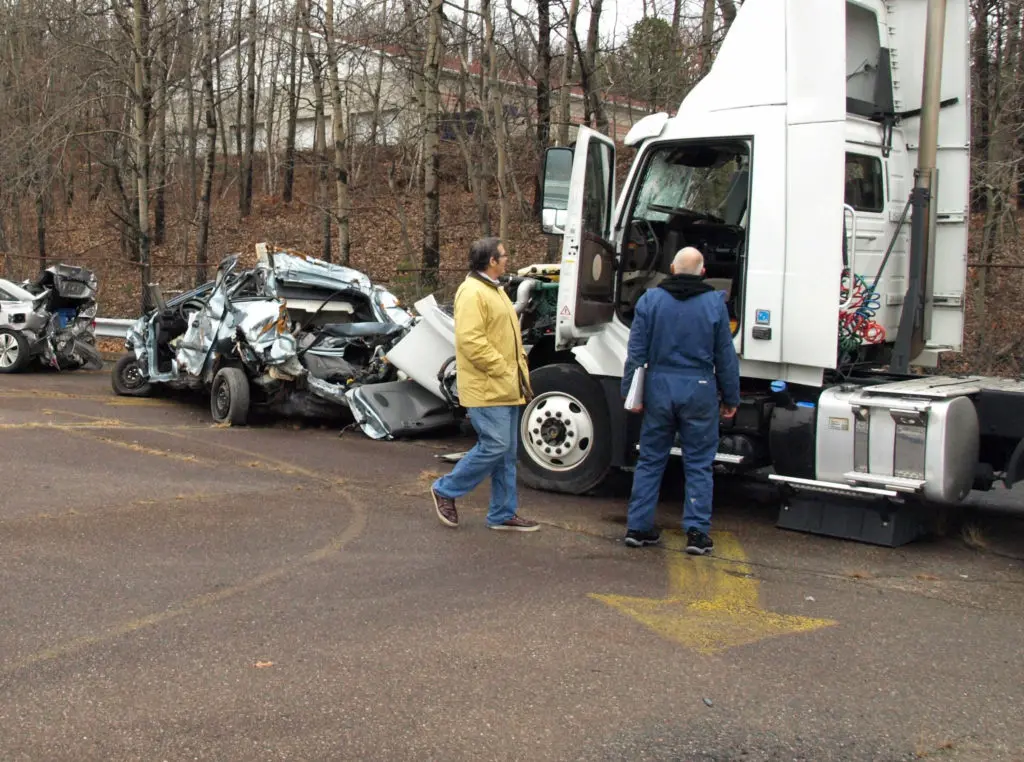What Are the Emergency Procedures a Truck Driver Must Take After a Truck Accident?
Truck drivers must comply with all regulated requirements for emergency efforts after a truck accident
Certain emergency procedures must be put into practice after a truck accident, and these efforts are mandatory for truck drivers. The Federal Motor Carrier Safety Administration (FMSCA) mandates rules and regulations to ensure safe roads, and trucker drivers have a definitive list of timely measures and protocols that must be taken when driving, and in the event of a truck accident.
If you or your loved one have been involved in a truck accident, dealing with the details and aftermath can be frustrating, stressful, and devastating: reach out to an experienced truck accident lawyer with a successful track record to get the support and guidance to ensure that no stone is left unturned. An experienced truck accident attorney at Munley Law has the resources and expertise to deal with commercial company’s representation and to fight for the compensation that you deserve.

What Are the Truck Driver’s Responsibilities at the Truck Crash Scene?
A 35,000-pound commercial semi-truck is much more lethal than a commuter car upon impact; vehicles of this magnitude require a specific skill set to maneuver, and the FMSCA has regulations to ensure that truck carrier companies employ and educate accordingly. Unfortunately, even when safety procedures are enforced, truck accidents happen. FMSCA guidelines strive to deter such scenarios by requiring logs, documentation, and follow-up. Should a truck accident occur; the truck driver is required to conduct emergency procedures in a prescribed, timely detailed manner. At the scene of the crash, the driver’s immediate requirements are:
- To report the truck crash to the authorities and to the employer/truck carrier company.
- Pull the vehicle to the side of the road, if possible.
- To check the cargo that may be transported; if cargo is leaking or posing danger, required emergency procedures must be executed to prevent avoidable (extended) spills. If there is a spill or question of one, a hazardous materials report must be completed.
- To use flares and emergency flares to alert oncoming traffic of areas to avoid, accounting for spills.
- To remain at the crash scene until authorities arrive and state that it is appropriate to leave; The Federal Motor Carrier Act supports this.
- To complete a comprehensive report detailing time (minute-to-minute, if possible), and lead-up to the accident, noting physical and property damages.
- To comply with obligatory drug and alcohol tests within a specified timeframe.
If you are the victim of a truck collision, these are all practices that must be taken by the truck driver and are all supported by the FMSCA’s regulations. Truck drivers who do not follow these procedures have violated FMSCA regulations. Your truck accident lawyer should be well-versed in truck litigation: required manual logs, electronic recording devices (“black boxes”), GPS logs, and disciplinary records must be secured. Additionally, all regulated commercial truck emergency procedures must be adhered to.
What Are the Truck Drivers’ Required Emergency Alert Warning Systems?
When a commercial-sized vehicle stops in the middle of the road — whether it be for a break, or due to an accident, certain procedures must be taken to alert oncoming traffic and to avoid danger. Reflective materials are also a requirement for commercial vehicles — it is an FMSCA and U.S. Department of Transportation (DOT) regulation.
Commercial trucks’ hazard warning system placement must be made when stopped on the highway or road shoulder for any reason other than an obligatory traffic stop. Once internal signals have been triggered (hazard lights), they must remain in effect until the regulated external alerts have been finalized. Should there be a collision, and should it be safe to do so, warning devices (reflective triangles, at least 6 fusee flares, or 3 liquid-burning flares(capable of burning 30 min, & 60 min with spare fuel)) must be placed within three locations:
- Approximately 10 feet (4 paces) from oncoming traffic.
- Approximately 100 feet (40 paces) from the vehicle, at the traffic lane or shoulder’s center, in the direction of oncoming traffic.
- Approximately 100 feet (40 paces) from the vehicle, at the traffic lane or shoulder’s center, in the direction away from oncoming traffic.
Should a flare be the used warning device, one must remain lit in each of the three locations (FMSCA 6.3.6 Emergency Warning Devices (392.22)). NO emergency flare with flames should be used if there combustible liquids or gas has leaked.
- Commercial trucks’ hazard warning systems in business or residential areas are not required during daylight; however, once streetlights and lamps are necessary, standard hazard procedures must be made.
- Commercial trucks’ hazard warning systems and hills, curves & obstructions require that the driver position a warning signal 100 to 500 feet between the commercial vehicle and the obstructed viewpoint.
- Commercial trucks & hazard warnings on one-way or divided roads require a warning device 10 feet from the vehicle’s rear, on the traffic side. Additionally, a warning device should be placed in the center or shoulder lane, 200 feet, and another at 100 feet from the commercial vehicle, in direction of oncoming traffic.
- Commercial trucks & reflective materials are required by the Federal Motor Carrier Safety Regulations (FMCSR) and are designed to minimize poor visibility issues. Stopped commercial vehicles at collision sites are unexpected and can be especially hazardous in the evening, prior to authorities coming. Trailers, tractors, flatbeds, and trailers need to comply; retrospective sheeting and reflex reflectors have specific placement regulations that are outlined in FMSCA’s Conspicuity Requirements for Commercial Motor Vehicles.
Hazard warning systems are requirements and their execution facilitates commercial vehicles to share the road with passenger vehicles. Truck drivers also must make inspections, and be in compliance with all before, during, and at their final destination. If you have been in a truck collision and these procedures were not properly executed, the truck driver was negligent in his roadside accident aftercare.

Truck Drivers Must Secure Their Cargo After a Truck Crash?
About 1 in every 14 commercial truck accidents is a cargo-related issue; US DOT requires that certain hazmat incidents, through the Pipeline and Hazardous Materials Safety Administration, in Hazardous Materials Regulations (49 CFR Parts 171-180), be reported. Hazmat driving education and troubleshooting is a requirement. No driver should get behind the wheel of a commercial vehicle loaded with hazmat cargo, without proper training.
Furthermore, Section 171.15 of the HMR requires an immediate telephone call (within 12 hours) to the National Response Center (NRC) following an incident (49 eCFR 171.15), for a report: 1-800-424-8802. Truck drivers transporting such cargo are required to be trained in emergency procedures and must follow suit to ensure the safety of roads.
Truck Drivers Must Take an Alcohol and Drug Test After a Collision
Alcohol and drug tests must be completed when requested; a truck collision triggers such a request, but the timing on when it should be taken depends on the nature of the truck accident. There are three different types of accidents that prompt or do not prompt testing:
- Tow-Away Accident: Commercial Motor Vehicle (CMV) drivers must have a test within 8 hours (alcohol) or 32 hours (drugs), for a moving violation arising from a crash. Post accident testing is not immediately required, and a citation must be issued.
- Bodily-injury accident: that result in immediate medical treatment, mandates that Commercial Motor Vehicle (CMV) drivers must have a test within 8 hours (alcohol) or 32 hours (drugs); postaccident, and immediate testing is a requirement, provided that a citation is issued.
- Fatality accident: always requires post-accident testing.
Employers are required to remove their employees from any safety-sensitive functions should they not comply, and do not have to wait for alerts. The FMCSA requires drug testing at various times during a commercial truck driver’s employment, including after accidents that meet certain criteria; however, if more than eight hours pass without an alcohol test, all attempts must cease. Employers who fail to get employees to test within those time limits must document the reasons tests were not administered and enforced to the FMSCA.
If you or your loved one have been involved in a truck accident, establishing negligence can be frustrating, stressful, and devastating: pain an suffering, financial obligations, medical bills, lost wages, recovery, and getting the compensation that you need, deserve, and are entitled to are all on the forefront. Safety after a commercial truck accident is regulated and a must; when truck drivers fail to follow proper protocol, everyone on the road is vulnerable., Our truck accident attorneys at Munley Law have in-depth knowledge of these frequently changing laws and regulations. We will determine whether a violation of this kind contributed to your crash, and hold the offending driver and/or company responsible.
If you were in a truck accident and need help with your claim, choose carefully. Contact the truck accident lawyer at Munley Law today to schedule a free consultation.
Posted in Truck Accidents.
Tagged Claim Damages Department of Transportation FMCSA Hazard Litigation Negligence Request









